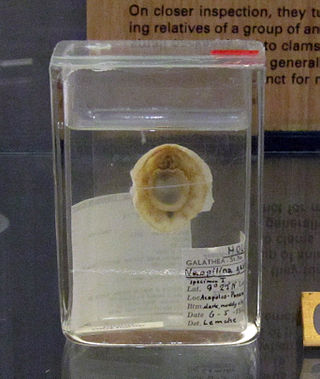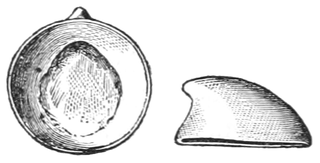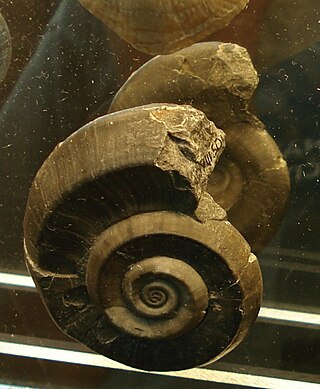
Monoplacophora, meaning "bearing one plate", is a polyphyletic superclass of molluscs with a cap-like shell, inhabiting deep sea environments. Extant representatives were not recognized as such until 1952; previously they were known only from the fossil record, and were thought to have become extinct 375 million years ago.

The Bellerophontida is a taxonomic order of extinct marine mollusks that are found in the fossil record from the Lower Cambrian to the Lower Triassic. They are considered by some experts to be primitive sea snails with primarily symmetrically coiled shells, marine gastropod mollusks.

The Bellerophontidae are an extinct family of specialized globose bellerophontids, Paleozoic and early Triassic mollusks of the class Gastropoda.

Bellerophontoidea, common name "bellerophonts", is a superfamily of extinct planospirally-coiled globose molluscs. This superfamily is generally included within the Gastropoda, but may instead be a group of monoplacophorans. The taxon first appeared late in the Cambrian and continued until late in the Triassic.
Khairkhaniidae is an extinct family of Paleozoic fossil molluscs of uncertain position. They are thought to belong to either the Gastropoda or Monoplacophora. They possess planispiral coiled shells with a columnar microstructure.
Ladamarekiidae is an extinct family of Paleozoic fossil molluscs of uncertain position. it is not known if they are sea snails.
Patelliconidae is an extinct family of Paleozoic fossil molluscs. It is not known whether these were Gastropoda or Monoplacophora.

†Archinacellidae is an extinct family of paleozoic molluscs of uncertain position.
†Archaeopragidae is an extinct family of paleozoic molluscs of uncertain position.

Pelagiellidae is an extinct family of Paleozoic fossil 'snails'. Some material assigned to this taxon represents gastropod molluscs, but some chaeta-bearing specimens first assigned to Pelagiella are perhaps better interpreted as tube-bearing annelid worms.
Tropidodiscidae is an extinct family of Paleozoic fossil molluscs with isostrophically coiled shells. They are of uncertain position taxonomically, in other words it is not known whether they were s.
Euphemitidae is an extinct family of Paleozoic fossil molluscs of uncertain position. They have isostrophically coiled shells and may be either Gastropoda sea (snail)s, or Monoplacophora.
Pterothecidae is an extinct family of Paleozoic molluscs of uncertain position, either Gastropoda or Monoplacophora, with isostrophically coiled shells.
Sinuitidae is an extinct family of Paleozoic molluscs of uncertain position. They had isostrophically coiled shells.

Macluritidae is an extinct family of relatively large, Lower Ordovician to Devonian, macluritacean gastropods(?), hypserstrophically coiled, that is dextral while appearing sinistral, of which the genus Maclurites is arch-typical. The base of their shells is flat or gently protruding while the upper side is generally concave.
Omphalotrochidae is an extinct taxonomic family of Paleozoic molluscs (gastropods?) with anisostrophically coiled shells of uncertain position (Gastropoda?).
Omphalocirridae is an extinct family of Paleozoic molluscs (gastropods?) with anisostrophically coiled shells of uncertain position (Gastropoda?).
Helicotomidae is an extinct family of Paleozoic molluscs (gastropods?) with anisostrophically coiled shells of uncertain position (Gastropoda?).

Lesueurillidae is an extinct family of paleozoic molluscs (gastropods?) with anisostrophically coiled shells of uncertain position (Gastropoda?).

Euomphaloidea, originally Euomphalacea, is an extinct superfamily of marine molluscs that lived from the Early Ordovician to the Late Cretaceous, included in the Gastropoda but speculated as instead perhaps Monoplacophora.









